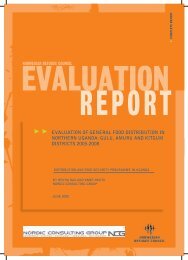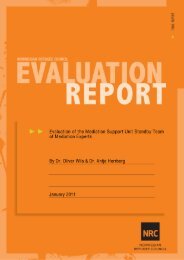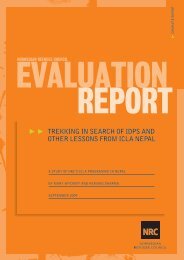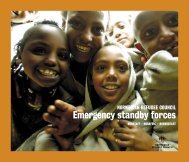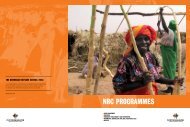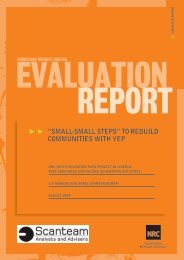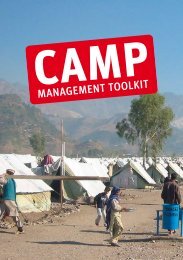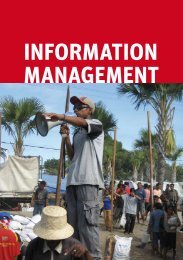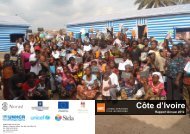Download report here - Norwegian Refugee Council
Download report here - Norwegian Refugee Council
Download report here - Norwegian Refugee Council
Create successful ePaper yourself
Turn your PDF publications into a flip-book with our unique Google optimized e-Paper software.
Evaluation of NRC Food Security and Livelihoods Projects in Chiredzi and Chipinge Districts of Zimbabwe4.4 Impacts On Community RelationshipsThe projects have generated significant improvements in relationships within the communities, with77.7% stating that these had improved a little (12.2%) or a lot (75.5%). Only 1.4% of respondents feltthat relationships had got slightly worse.Table 4.7 Has participating in the project had any impacts on relationships in the household?Food Security and LivelihoodProgramMuchWorseSlightlyWorseNoChangeImprovedSlightlyImproveda LotNumber(N)(%) (%) (%) (%) (%)Conservation Agriculture 0 0 2.6 27.6 69.8 116Low Input Gardens 0 0 2.1 0.7 97.2 141Small Livestock 0 5.8 31.4 2.6 60.3 156Market Linkages 0 1.0 1.0 35.1 62.9 97Income Generating Activities 0 0 21.3 3.3 75.4 61Unconditional Cash Transfer 0 0 7 12 109 128Total (All Programs) 0.0 1.4 10.9 12.2 75.5 699A significant number in all groups agreed t<strong>here</strong> has been benefits to the community arising fromincreased working together, and an increase in sharing, exchanging and lending between communitymembers. This related not just to material goods, but also to sharing of ideas and skills. Increased trustwithin the community had increased opportunities for borrowing and lending and the giving of credit.T<strong>here</strong> has also been increased interactions between different members of the community, leading tonew friendships and a strengthening of existing friendships. The community has also benefited from adecrease in the level of begging and a reduced feeling of dependence on others. This was particularlynoted by recipients of conditional and unconditional cash grants.Reasons for improvements in community relationships (ranked according to the frequency with whichthey were mentioned) were:1. Increased sharing / lending / exchanging, and helping each other2. Working together3. Sharing skills and ideas4. Increased friendships / strengthening of existing friendships5. No longer begging / dependent of others6. Happy for others7. Ownership of animals / more animals / better quality animals in the community8. Increased esteem in the eyes of the community9. Increased sense of belonging together10. Improved trust / more ability to borrow or give credit11. Sharing of the borehole12. More interaction due to trade / passing on livestock13. Reduction in theftThe exception was small livestock beneficiaries who saw the ownership of livestock and the status thatthat gives as the key factor enhancing community relationships. One even declared that the communitywas “now rich”. This group had the most respondents seeing little or no change in community relations.T<strong>here</strong> were indications of tensions arising from resentment amongst people who were not included fromthe project (the main cause of worsening relationships, mentioned 14 times). A small number of tensionsresulted from isolated incidents such as pigs getting into neighbours gardens, disputes over the sharingof borehole water, and delays / perceived failures to act in good faith in the passing on of goats.A detailed breakdown of the number of times the factors were mentioned disaggregated by project typeis contained in Appendix 4.7




